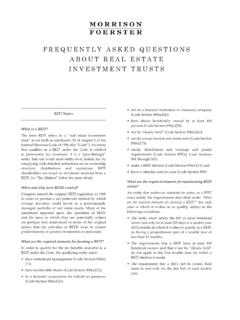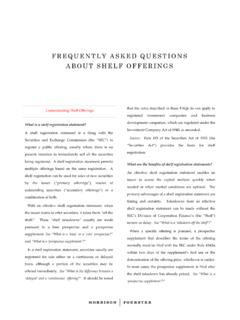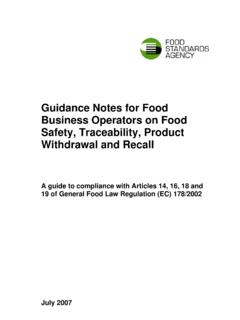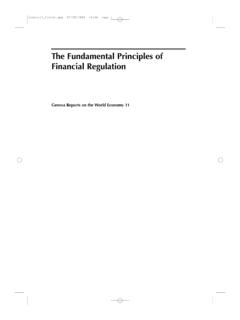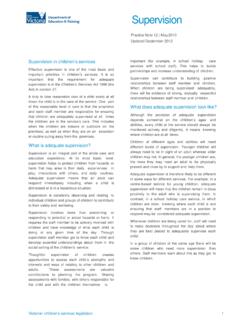Transcription of Frequently Asked Questions about Regulation S
1 F R E Q U E N T L Y A S K E D Q U ES T I O N S A B O U T R E G U L A T IO N S Understanding Regulation S What is Regulation S? Regulation S provides an exclusion from the Section 5 registration requirements of the Securities Act of 1933, as amended (the Securities Act ), for offerings made outside the United States by both and foreign issuers. A securities offering, whether private or public, made by an issuer outside of the United States in reliance on Regulation S need not be registered under the Securities Act. The Regulation S safe harbors are non-exclusive, meaning that an issuer that attempts to comply with Regulation S also may claim the availability of another applicable exemption from registration.
2 Regulation S is available for offerings of both equity and debt securities. Regulation S is available only for offers and sales of securities outside the United States made in good faith and not as a means of circumventing the registration provisions of the Securities Act. The availability of the issuer (Rule 903) and the resale (Rule 904) safe harbors is contingent on two general conditions: the offer or sale must be made in an offshore transaction; and no directed selling efforts may be made by the issuer, a distributor, any of their respective affiliates, or any person acting on their behalf. Regulation S is composed of the following parts: eight preliminary notes ; Rule 901, which contains a general statement of the Regulation ; Rule 902, which sets forth applicable definitions; Rules 903 and 904, which set forth the two safe harbors; and Rule 905, which sets forth the resale limitations applicable to equity securities.
3 Who may rely on Regulation S? Members of the offering party, including: issuers both reporting and non-reporting issuers may rely on the Rule 901 general statement or the Rule 903 issuer safe harbor; Foreign issuers both reporting and non-reporting foreign issuers may rely on the Rule 901 general statement or the Rule 903 issuer safe harbor; Distributors (underwriters and broker-dealers) both and foreign financial intermediaries may rely on the Rule 901 general statement or the Rule 903 issuer safe harbor; Affiliates of the issuer both and foreign; Morrison & Foerster LLP 2 Any persons acting on behalf of the aforementioned persons; resident purchasers (including dealers) who are not offering participants may rely on the Rule 901 general statement or the Rule 904 resale safe harbor to transfer securities purchased in a Regulation S offering.
4 And residents (including dealers) who are not offering participants may rely on the Rule 901 general statement or the Rule 904 resale safe harbors in connection with purchases of securities on the trading floor of an established foreign securities exchange that is located outside the United States or through the facilities of a designated offshore securities market. Who may not rely on Regulation S? Regulation S is not available for the offer and sale of securities issued by open-end investment companies, unit investment trusts registered or required to be registered under the Investment Company Act of 1940 (the 1940 Act ), or closed-end investment companies required to be registered, but not registered, under the 1940 Act.
5 What types of transactions are conducted under Regulation S? There are several types of Regulation S offerings that or foreign issuers may conduct: a standalone Regulation S offering, in which the issuer conducts an offering of debt or equity securities solely in one or more countries; a combined Regulation S offering outside the United States and Rule 144A offering inside the United States; and Regulation S continuous offering programs for debt securities, including various types of medium-term note programs (these continuous offering programs may be combined with an issuance of securities to qualified institutional buyers ( QIBs ) in the United States under Rule 144A).
6 Two other types of offerings also are permitted by Regulation S: (1) offerings made under specified conditions pursuant to an employee benefit plan established and administered in accordance with the law of a country other than the United States and in accordance with that country s practices and documentation;1 and (2) offerings of foreign government securities. The Regulation S portion of any offering refers only to the portion of the offering that requires the offering participants to comply with Regulation S in order to benefit from the safe harbor. The offering itself also must comply with the requirements of the applicable jurisdictions and the requirements of any foreign securities exchange or other listing authority.
7 A Regulation S-compliant offering could be combined with a registered public offering in the United States or an offering exempt from registration in the United States, as well as be structured as a public or private offering in one or more jurisdictions. 1 For an offering of securities pursuant to an employee benefit plan, the laws, customary practices and documentation with respect to such employee benefit plan may be those of the European Union rather than of a country other than the United States. See Securities Act Rules Compliance and Disclosure Interpretations ( C&DI ), Question No.
8 Morrison & Foerster LLP 3 What conditions must be satisfied to rely on Regulation S? Both the issuer and resale safe harbors of Regulation S are available to market participants only if (1) the offer or sale is made as part of an offshore transaction and (2) none of the parties make any directed selling efforts in the United States. In addition, offerings made in reliance on Rule 903 are subject to additional restrictions that are calibrated to the level of risk that securities in a particular type of transaction will flow back into the United States. Rule 903 distinguishes three categories of transactions based on the type of securities being offered and sold, whether the issuer is domestic or foreign, whether the issuer is a reporting issuer under the Securities Exchange Act of 1934, as amended (the Exchange Act ), and whether there is a substantial market interest or SUSMI.
9 Category 1 transactions are those in which the securities are least likely to flow back into the United States. Therefore, the only restrictions are that the transaction must be an offshore transaction and that there be no directed selling efforts in the United States. Category 2 and Category 3 transactions are subject to an increasing number of offering and transactional restrictions for the duration of the applicable distribution compliance period. Distribution compliance period is defined in Rule 902(f) generally as the period following the offering when any offer or sales of Category 2 or 3 securities must be made in compliance with the requirements of Regulation S in order to prevent the flow back of the offered securities into the United States.
10 The period ranges from 40 days to six months for reporting issuers or one year for equity securities of non-reporting issuers. For further discussion of transactions conducted under Categories 1, 2 and 3, see Eligible Transactions below. Can issuers conduct exempt or excluded offerings concurrently with Regulation S transactions? Yes. For purposes of determining whether Rule 903 s general requirement for offshore transactions is met, a contemporaneous registered offering or exempt private placement in the United States will not be integrated with an offshore offering that otherwise complies with Regulation S. In fact, Regulation S contemplates that a private placement in the United States may be made simultaneously with an offshore public offering in reliance on the issuer safe harbor.



